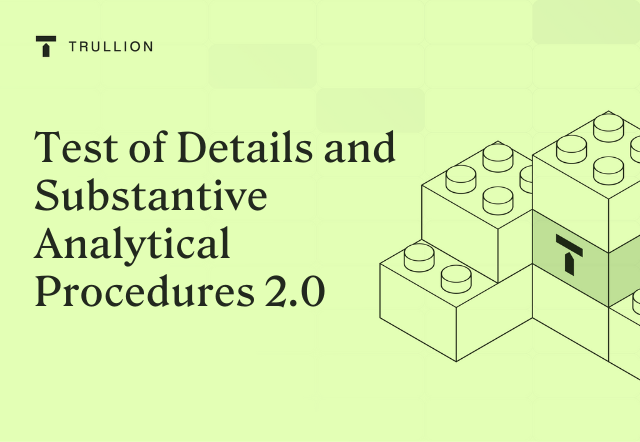Introduction
Accurate and reliable financial statements are vital for investors, regulators, and other stakeholders, as these underpin the global financial system. To achieve this assurance, auditors employ testing procedures to verify transactions and balances, as well as to identify any misstatements or irregularities.
The two main approaches used in this process are Test of Controls, and Substantive Testing – which includes Test of Details and Substantive Analytical Procedures.
We’ll explore the significance of effective testing procedures in financial audits, with a focus on comparing these two substantive approaches.
As financial transactions become intricate, auditors must navigate challenges with adaptable testing procedures. Striking the right balance between Test of Details vs. Substantive Testing empowers auditors to boost efficiency and accuracy, and uncover potential misstatements, and safeguard stakeholders’ interests.
Understanding Test of Details
Test of Details is a specific type of audit procedure used by auditors to obtain detailed evidence about individual transactions, account balances, or items in the financial statements.
The purpose of the Test of Details is to assess the accuracy, completeness, and validity of financial information contained within the accounts and transactions under examination. This testing methodology involves a thorough and meticulous examination of supporting documentation and evidence to verify the integrity of the financial data and ensure compliance with accounting principles, regulations, and organizational policies.
The Role Of Test Of Details In Detecting Misstatements
Thanks to its granularity, the Test of Details also plays a crucial role in detecting misstatements within the financial statements during the audit process. It is also effective when it comes to detecting fraudulent activities or intentional misstatements within financial records.
In addition to identifying misstatements, the Test of Details also serves as a means to evaluate the effectiveness of an organization’s internal controls. Weak internal controls can contribute to misstatements, and auditors’ assessment of control deficiencies helps recommend necessary improvements.
Exploring Substantive Analytical Procedures
Substantive Analytical Procedures are a fundamental type of audit procedure used by auditors to obtain direct and substantive evidence about the accuracy and validity of the components of financial statements.
Substantive procedures provide a high level of assurance to stakeholders that the financial information presented is free from significant inaccuracies and fairly represents the financial position and performance of the organization.
Significance of Substantive Analytical Testing
Substantive analytical procedures are significant in that they are used to:
- Identify misstatements
- Ensure financial statement reliability
- Support the audit opinion
- Complement Tests of Controls
- Detect fraud
- Enhance audit quality
Test of Details vs. Substantive Analytical Testing
The critical difference between the Test of Details vs. Substantive Analytical Procedures is that the Test of Details involves a thorough examination of individual transactions and account balances, while the analytical procedures process takes a broader approach to assess the overall fairness of financial statements.
When to Use Test of Details vs. Substantive Testing
The decision of whether to use a Test of Details vs. Substantive Analytical Testing depends on the auditor’s assessment of the engagement and the audit risk factors involved. Test of Details is typically employed when auditors need to obtain specific and detailed evidence about particular transactions or account balances. This method is particularly useful when there is a higher risk of misstatements or when the auditor needs to examine the accuracy and completeness of individual items in the financial statements.
On the other hand, Substantive Analytical Testing is more appropriate when auditors aim to assess the overall fairness and reliability of the financial statements. It involves high-level analysis and a broader assessment of financial data to identify trends, significant fluctuations, or inconsistencies. Substantive Analytical Testing is particularly relevant when the auditor believes that the financial statements may contain material misstatements, and there is a need to obtain a reasonable level of assurance about the financial information as a whole.
How Test of Details and Substantive Analytical Testing Complement Each Other
Test of Details and Substantive Analytical Procedures are not mutually exclusive; instead, they complement each other to ensure a thorough and comprehensive audit approach. While the Test of Details provides an in-depth examination of individual transactions, it contributes to Substantive Analytical Testing by providing specific evidence to support and vouch for the overall financial statement assertions. The detailed testing carried out in the Test of Details enhances the auditor’s understanding of the financial data, which is then used in Substantive Analytical Procedures to draw conclusions about the fairness and accuracy of the financial statements.
Moreover, the results obtained from Substantive Analytical Testing may lead auditors to identify areas with a higher risk of misstatement, prompting them to conduct further Test of Details procedures in those specific areas. By using both approaches in conjunction, auditors can strengthen their audit conclusions and provide a more robust opinion on the financial statements.
Test of Details: Procedures and Techniques
Now we’ll dive deeper into the purpose of the test of details procedures, sampling methods and sample selection, and examples of specific Test of Details procedures commonly employed by auditors.
Auditors employ various sampling methods to select items for Test of Details procedures, ensuring that the sample represents a reliable cross-section of the population being tested. Random sampling, systematic sampling, and stratified sampling are some common approaches used in the Test of Details. The choice of sampling method depends on the audit objectives, the risk of misstatement, and the level of confidence required in the results.
Several Test of Details procedures can be employed by auditors to gain insights into the accuracy and validity of financial data. Two common examples are confirmation and vouching:
- Confirmation: In this procedure, auditors directly communicate with third parties, such as customers, vendors, or financial institutions, to verify the accuracy and existence of specific account balances or transactions. Confirmations are particularly useful for validating accounts receivable balances, bank balances, and outstanding liabilities.
- Vouching: Vouching involves tracing individual transactions from the financial statements back to the supporting documentation, such as invoices, receipts, or contracts. This procedure ensures that recorded transactions are supported by appropriate and valid documentation, providing evidence of their accuracy and legitimacy.
Substantive Analytical Testing Procedures and Approaches
While there are many elements to substantive testing, one of the most common is Analytical Procedures. Analytical Procedures play a vital role in substantive testing, allowing auditors to assess the overall reasonableness of financial data by analyzing relationships and trends. By comparing financial ratios, percentages, or other relevant metrics across different periods or with industry benchmarks, auditors can identify significant fluctuations or anomalies that may indicate potential misstatements or irregularities. This is particularly relevant today, given technological developments such as AI-powered accounting and auditing software.
To further illustrate Substantive Analytical Procedures, we’ve included some examples:
Examples of Substantive Testing Approaches
- Trend Analysis: Comparing financial data over multiple periods to identify significant changes or trends. For example, analyzing the revenue growth of a company over the past five years to determine if it aligns with industry benchmarks.
- Ratio Analysis: Calculating and comparing financial ratios, such as liquidity ratios (current ratio, quick ratio), profitability ratios (gross profit margin, net profit margin), and efficiency ratios (inventory turnover, accounts receivable turnover), to assess the financial health and performance of a business.
- Regression Analysis: Using statistical methods to assess the relationship between two or more variables, such as sales and advertising expenses. This can help auditors identify outliers or unusual patterns that may warrant further investigation.
- Reasonableness Testing: Comparing financial information with expectations based on industry norms, benchmarks, or management forecasts. For instance, verifying if the salaries and benefits expense of a company is in line with similar-sized companies in the same industry.
- Gross Profit Analysis: Review the gross profit margin to identify potential issues with inventory valuation, cost of goods sold, or sales returns and allowances.
- Expense Analysis: Review various expense accounts for unusual fluctuations or patterns that may indicate errors or fraud.
Factors Influencing Test Selection
In the process of planning and conducting financial audits, auditors carefully consider various factors that influence the selection of appropriate audit tests. These factors play a crucial role in determining the scope and nature of the audit procedures to be applied. Three key factors that significantly influence test selection are risk assessment and materiality considerations, the nature and complexity of the financial statement items, and the availability of reliable internal controls.
Risk Assessment and Materiality Considerations
Risk assessment is a fundamental step in the audit process, where auditors evaluate the risks associated with potential misstatements in the financial statements. This evaluation helps auditors prioritize their efforts and allocate resources effectively. High-risk areas with a higher likelihood of material misstatements may require more extensive and detailed testing procedures, while low-risk areas may be subject to less rigorous testing.
Materiality considerations also influence the selection of audit tests. Materiality represents the level at which misstatements could reasonably influence the decisions of users relying on financial statements.
Nature and Complexity of the Financial Statement Items
The nature and complexity of financial statement items play a significant role in determining the appropriate audit tests. Different account balances and transactions may require different testing procedures. For example, complex financial instruments or revenue recognition policies may necessitate more specialized testing techniques to ensure accurate reporting. Conversely, simple and straightforward accounts may only require basic testing procedures.
Availability of Reliable Internal Controls
The presence and effectiveness of internal controls are essential considerations in test selection. Strong internal controls provide reasonable assurance that financial data is accurately recorded and reliable. When robust internal controls exist, auditors may rely on them to some extent. However, in the absence of reliable internal controls or if controls are deemed ineffective, auditors may increase the extent and depth of testing to compensate for the lack of control reliance.
Best Practices for Effective Testing
When it comes to effective testing – for both Substantive Analytical Procedures and Tests of Detail – there are some best practices that are generally followed.
Planning and Scoping the Testing Procedures
Effective testing begins with comprehensive planning and scoping. Auditors should carefully assess the specific risks associated with the audit engagement, identifying areas that require increased scrutiny. By understanding the business environment, industry, and regulatory requirements, auditors can tailor their testing procedures to focus on the most critical and high-risk areas. Adequate planning ensures that testing efforts are efficient, relevant, and aligned with the overall audit objectives.
Documentation and Workpaper Organization
Thorough documentation is essential for effective testing. Auditors should maintain clear and well-organized work papers that provide a detailed account of the testing procedures performed, the evidence gathered, and the conclusions reached. Properly documented work papers not only facilitate communication and collaboration among the audit team but also serve as a reliable reference for future audits and external reviews. Organized work papers enhance transparency and make it easier for others to follow the audit trail.
Quality Control and Review Processes
Implementing robust quality control and review processes is crucial for maintaining the integrity and accuracy of the audit work. Regular reviews by senior team members or quality control personnel help identify any potential errors, omissions, or inconsistencies in the testing procedures and work papers. These reviews ensure that the audit is conducted in accordance with professional standards and firm policies. Emphasizing quality control measures also instills confidence in the audit outcomes and the reliability of the financial statements.
Technology and Automation in Testing
As mentioned previously, technology and automation are assuming an increasingly important role in audit testing.
Advanced software, data analytics, and automation tools enable auditors to process vast amounts of financial data more efficiently and accurately. With technology-driven approaches, auditors can identify patterns, anomalies, and trends in the data, leading to more informed and data-driven decisions during testing.
Automated Tools for Test of Details and Substantive Analytical Testing
Automated tools have revolutionized both Tests of Details and Substantive Testing Processes. In Test of Details, auditors can use data extraction tools to gather and analyze large volumes of transactional data swiftly. These tools facilitate the comparison of recorded data with source documents, simplifying vouching and confirmation procedures. Similarly, in Substantive Analytical Testing, data analytics tools allow auditors to perform extensive analytical procedures on financial data, identifying significant fluctuations or outliers that may warrant further investigation.
Benefits and Challenges of Technology Adoption in Auditing
The adoption of technology in auditing offers numerous benefits. Firstly, it enhances audit efficiency by reducing the time required for data collection, analysis, and testing. Automation reduces manual effort, enabling auditors to focus on higher-value tasks, such as data interpretation and professional judgment. Moreover, technology-driven audit procedures enhance audit quality and accuracy, as repetitive tasks are less prone to human error. The integration of automated tools also strengthens the consistency and standardization of audit processes across engagements.
However, technology adoption in auditing also presents challenges. Implementation costs, training requirements, and potential data security risks are significant considerations for firms. Ensuring data accuracy and validity in automated processes is critical to maintaining the reliability of audit outcomes. Additionally, while automation facilitates certain aspects of testing, auditors must strike a balance between reliance on automated procedures and the exercise of professional skepticism, as the human element remains essential in audit judgment.
Importance of Professional Judgment in Testing
Professional judgment is a cornerstone of effective testing in financial audits. Auditors must approach their work with professional skepticism, maintaining an attitude of questioning and a willingness to challenge assumptions and evidence. Critical thinking skills are essential in assessing the appropriateness and relevance of audit evidence, allowing auditors to make informed decisions about the scope and nature of testing procedures. Professional skepticism helps auditors remain objective and impartial, avoiding undue reliance on automated tools or preconceived notions during the testing process.
Evaluating and Interpreting Testing Results
The ability to evaluate and interpret testing results is crucial for auditors to draw meaningful conclusions about the accuracy and validity of financial data. Professional judgment comes into play when determining the materiality and significance of identified misstatements or anomalies. Auditors must exercise sound judgment to distinguish between minor errors and material misstatements that could influence the financial statements’ overall fairness. Through analytical reasoning and a deep understanding of the business environment, auditors can provide valuable insights and recommendations to address any identified issues.
Communicating Findings and Recommendations Effectively
Clear and effective communication of testing findings and recommendations is a vital aspect of the auditing process. Auditors must present their conclusions in a manner that is understandable to stakeholders with varying levels of financial expertise. Professional judgment enables auditors to prioritize and highlight the most critical issues, ensuring that key findings receive proper attention. Effective communication fosters transparency and enables management and stakeholders to take prompt action on any identified deficiencies or risks.
How Trullion Can Help
Trullion makes auditing a smoother and more efficient process than many people imagine is possible.
As an AI-powered accounting and audit platform, Trullion empowers auditors to access clear audit trails, seamlessly trace data to the source, and collaborate with clients, effortlessly.
As Paul Wolff, Emerging Technologies Specialist at firm MHM (Mayer Hoffman McCann P.C.) puts it, “Trullion has proved to be a very useful and time-saving tool for MHM in evaluating and testing our client’s adoption of ASC 842. The OCR and machine learning capabilities provide efficiencies for the audit teams, and we have found the lease modification features particularly helpful.”
Test of Details and Substantive Analytical Testing for the 21st Century
In this comprehensive article, we’ve clarified the key differences between the Test of Details and Substantive Analytical Testing, together with how to best use each of these approaches effectively in an audit engagement.
We’ve also touched on the future of audit and what it means for these types of testing, and how your firm can leverage the benefits of AI-powered accounting and auditing to emerge as leaders in the field.
Learn more about how Trullion can drive value for your organization: set up a call with a product expert today.







